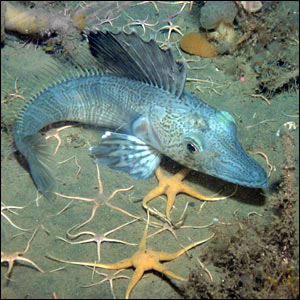
Have you heard about the amazing ice fish? One of the extraordinary evolutionary adaptations found in the extreme Antarctic cold is found in the ice fish. The fish has no red blood cells and no hemoglobin, so its blood plasma flows more freely. The oxygen that its muscles need simply dissolves in the plasma. [photo source: BBC News]
.
tags: ice fish, Antarctica
More like this
Puffer fish are notorious. Considerable delicacy in Japan (a taste adopted by some non-Japanese Foodies), they come with a side of risk: some puffer fish have the potent lethal toxins tetrodotoxin and/or saxitoxin, neurotoxins more than 1000 times the lethal potency of cyanide:
A not at all exhaustive collection of cool bizarro aquariums.
I'm a big fish eater. In general, given a choice about what to eat, I'm
usually happiest when I get to eat a nice fish. Even now that I've started eating
beef again, most of the time, I'd rather eat a nice piece of wild salmon
than pretty much anything made of beef.
A fascinating new study published in the Proceedings of the National Academy of Sciences suggests that the impact of human fishing may be reducing the fitness of fish populations overall.

Have you heard about the amazing ice fish?
It's not just one fish - it's a whole family, Channichthyidae, with about 11 genera and 15 species.
I just heard about these things today - a commenter on my blog requested I look into them.
I've just been reading paper abstracts so far, but the short version is they have no red blood cells because the genes for haemoglobin and myoglobin have been deleted. There's some speculation that their current high-efficiency circulatory systems (larger blood vessels, higher pressures, etc) are partly a physiological (i.e. phenotypic plasticity) adaptation to reduced oxygen loads, based on comparisons with related fishes. One paper (by K-H Kock, 2005, I think) asserts that the loss of RBC has imposed a net cost on these fishes, and that this phenotype does not increase relative fitness. Somehow they've just managed to cope with lower tissue-oxygen concentrations.
Also, they're very, very pretty.
They are fascinating creatures and Dr. Sean B. Carroll gives a great description of the evolution of the icefish in his book "The Making of the Fittest". The history of the evolution is clearly written in the genes and most if not all of the steps in the process are clearly defined and are extremely convincing evidence of evolution. he covers the gene deletions as well as the mutations that enable the fish to make antifreeze.
The oxygen that its muscles need simply dissolves in the plasma.
Humans can do that too! It's the basis of hyperbaric oxygen therapy for carbon monoxide poisoning: see, for example, this BMJ article. That's pretty amazing too.
Let's not cause the cool brittle stars to feel left out. While at Sanibel Island, Florida, vacationing from high school,I ran my hands through the sediment in an inch or two of water by the shore and came up with live brittle stars. Now we know they have tiny calcite "eyes" in their arms, adding to their mysterious nature. I can't help wondering what it is like to "be" one of these invertebrates, if the question has any meaning at all. We are so chauvanistic about our top-predator position and misguided intellectual abilities that are enabling us to turn the world into a weed patch.
Cool fishes indeed. They can live in seawater that is colder than the freezing point of their own body fluids.